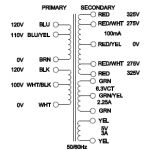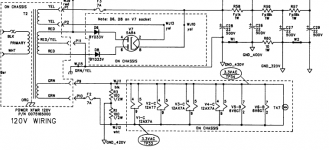Hello,
I'm repairing a Fender 65 Princeton Reverb reissue amp. Its power transformer has blown.
I've ordered a replacement part : Hammond 291AEX which suits this amp.
The difference is that 291AEX uses a center tap for heaters.
Looking at the schematic of the Princeton Reverb reissue :
The original power transformer doesn't use a CT for heaters.
What would be the best way to wire the new transformer?
1) Leave the CT unwired and only connect the two green wires?
2) Use the CT and take away from the PCB the two 100R resistors that creates an artificial CT? In this cas, CT sould be wired to ground point GND_420V?
3) what would happen if I leave the 2 resistors and use the CT?
thanks for your help,
rgds,
Ed
I'm repairing a Fender 65 Princeton Reverb reissue amp. Its power transformer has blown.
I've ordered a replacement part : Hammond 291AEX which suits this amp.
The difference is that 291AEX uses a center tap for heaters.
Looking at the schematic of the Princeton Reverb reissue :
The original power transformer doesn't use a CT for heaters.
What would be the best way to wire the new transformer?
1) Leave the CT unwired and only connect the two green wires?
2) Use the CT and take away from the PCB the two 100R resistors that creates an artificial CT? In this cas, CT sould be wired to ground point GND_420V?
3) what would happen if I leave the 2 resistors and use the CT?
thanks for your help,
rgds,
Ed
Attachments
1/ Leave it as it is and don't connect the CT of the heaters.
2/ Connect the CT to the chassis point and remove the two 100R resistors.
3/ Connect as point 2 and leave the 100R resistors where they are, 3.15v AC across 100R is nothing to worry about.
The choice is yours and makes no difference what you do.
2/ Connect the CT to the chassis point and remove the two 100R resistors.
3/ Connect as point 2 and leave the 100R resistors where they are, 3.15v AC across 100R is nothing to worry about.
The choice is yours and makes no difference what you do.
Hello,
thanks for your help.
OK so i can use the CT AND keep the two resistors (maybe it would add a bit of insurance, right?)
case 2 involves some desoldering/soldering and unscrewing PCB, so if case 3 is OK, no need to do more than necessary.
rgds,
thanks for your help.
OK so i can use the CT AND keep the two resistors (maybe it would add a bit of insurance, right?)
case 2 involves some desoldering/soldering and unscrewing PCB, so if case 3 is OK, no need to do more than necessary.
rgds,


 Thread moved to Instruments and Amps
Thread moved to Instruments and Amps